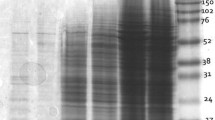Abstract
In this study, three methods of protein extraction from the seeds of the Chinese fir were compared by examining the quality (including the number of protein spots observed) in the two-dimensional gel electrophoresis (2-DE), obtained by isoelectric focusing and sodium dodecyl sulfate polyacrylamide gel electrophoresis of the total released protein. Three protein extraction methods were: TCA-acetone precipitation, SDS extraction/acetone precipitation, and phenol extraction methanol/ammonium acetate precipitation. The results showed that TCA-acetone precipitation was the most effective method for protein extraction; it gave the highest yield of total protein (8.9 mg protein per g seed weight) and the greatest number of proteins spots (1,034 spots) on the 2-DE gel. Further, several proteins were identified by liquid chromatography mass spectrometry (LC MS/MS), which are legumin-like storage protein, similar to AMP binding/acetate-CoA ligase, similar to 40S ribosomal protein S20, actin, ascorbate peroxidase, Similar to cysteine synthase, and unknown protein. These data demonstrates that TCA-acetone precipitation followed by 2-DE and LC MS/MS is a suitable method for proteomic analysis of coniferous species, such as Chinese fir and provides a valuable starting point for similar proteomic analysis of other coniferous tree species.




Similar content being viewed by others
Abbreviations
- CHAPS 3:
-
[(3-Cholamidopropyl) dimethylamonio]-1-propanesulfonate
- 2-DE:
-
Two-dimensional gel electrophoresis
- DTT:
-
Dithiothreitol
- IEF:
-
Isoelectric focusing
- LC:
-
Liquid chromatography
- MS:
-
Mass spectrometry
- SDS-PAGE:
-
Sodium dodecyl sulfate polyacrylamide gel electrophoresis
- TCA:
-
Trichloroacetic acid
- Tris:
-
Tris (hydroxymethyl) aminomethane
References
Baerenfaller K, Grossmann J, Grobei MA et al (2008) Genome-scale proteomics reveals Arabidopsis thaliana gene models and proteome dynamics. Science 320:938–941
Baggerman G, Vierstraete E, De Loof A et al (2005) Gel-based versus gel-free proteomics: a review. Comb Chem High Throughput Screen 8:669–677
Delaplace P, van der Wal F, Dierick J et al (2006) Potato tuber proteomics: comparison of two complementary extraction methods designed for 2-DE of acidic proteins. Proteomics 6:6494–6497
dos Santos ALW, Wiethölter N, Gueddari NEE et al (2006) Protein expression during seed development in Araucaria angustifolia: transient accumulation of class IV chitinases and arabinogalactan proteins. Physiol Plant 127:138–148
Filonova LH, von Arnold S, Daniel G et al (2002) Programmed cell death eliminates all but one embryo in a polyembryonic plant seed. Cell Death Differ 9:1057–1062
Giavalisco P, Nordhoff E, Lehrach H et al (2003) Extraction of proteins from plant tissues for two-dimensional electrophoresis analysis. Electrophoresis 24:207–216
Jorrin-Novo JV, Maldonado AM, Echevarria-Zomeno S et al (2009) Plant proteomics update (2007–2008): Second-generation proteomic techniques, an appropriate experimental design, and data analysis to fulfill MIAPE standards, increase plant proteome coverage and expand biological knowledge. J Proteomics 72:285–314
Klimaszewskaa K, Morencya F, Jones-Overtona C et al (2004) Accumulation pattern and identification of seed storage proteins in zygotic embryos of Pinus strobus and in somatic embryos from different maturation treatments. Physiol Plant 121:682–690
Lippert D, Zhuang J, Ralph S et al (2005) Proteome analysis of early somatic embryogenesis in Picea glauca. Proteomics 5:461–473
Maldonado AM, Echevarría-Zomeño S, Jean-Baptiste S et al (2008) Evaluation of three different protocols of protein extraction for Arabidopsis thaliana leaf proteome analysis by two-dimensional electrophoresis. J Proteomics 71:461–472
Mijnsbrugge KV, Meyermans H, Van Montagu M et al (2000) Wood formation in poplar: identification, characterization, and seasonal variation of xylem proteins. Planta 210:559–589
Rose JK, Bashir S, Giovannoni JJ et al (2004) Tackling the plant proteome: practical approaches, hurdles and experimental tools. Plant J 39:715–733
Rossignol M, Peltier JB, Mock HP et al (2006) Plant proteome analysis: a 2004–2006 update. Proteomics 6:5529–5548
Sallandrouze A, Faurobert M, Maâtaoui ME (2002) Characterization of the developmental stages of cypress zygotic embryos by two-dimensional electrophoresis and by cytochemistry. Physiol Plant 114:608–618
Santoni V, Bellini C, Caboche M (1994) Use of 2-dimensional protein-pattern analysis for the characterization of Arabidopsis thaliana mutants. Planta 192:557–566
Sheoran IS, Ross ARS, Olson DJH et al (2009) Compatibility of plant protein extraction methods with mass spectrometry for proteome analysis. Plant Sci 176:99–104
Shevchenko A, Wilm M, Vorm O et al (1996) Mass spectrometric sequencing of proteins from silver-stained polyacrylamide gels. Anal Chem 68:850–858
Song J, Braun G, Bevis E et al (2006) A simple protocol for protein extraction of recalcitrant fruit tissues suitable for 2-DE and MS analysis. Electrophoresis 27:3144–3151
West MAL, Harada JJ (1993) Embryogenesis in higher plants: an overview. Plant Cell 5:1361–1369
Wu FS, Wang MY (1984) Extraction of proteins for sodium dodecyl sulfate-polyacrylamide gel electrophoresis from protease-rich plant tissues. Anal Biochem 139:100–103
Acknowledgments
This study has been supported grants by National Natural Science Foundation of China (31000287), by Natural Science Foundation of Higher Education of Jiangsu Province (10KJB220002) and National Natural Science Foundation of China (30930077). The authors gratefully acknowledge technical support kindly provided by the Shanghai Applied Protein Technology Co. Ltd. for their kindfuly technical support in the use of LC MS/MS.
Author information
Authors and Affiliations
Corresponding author
Additional information
Communicated by J. V. Jorrin-Novo.
Electronic supplementary material
Below is the link to the electronic supplementary material.
Rights and permissions
About this article
Cite this article
Zhen, Y., Shi, J. Evaluation of sample extraction methods for proteomic analysis of coniferous seeds. Acta Physiol Plant 33, 1623–1630 (2011). https://doi.org/10.1007/s11738-010-0697-1
Received:
Revised:
Accepted:
Published:
Issue Date:
DOI: https://doi.org/10.1007/s11738-010-0697-1




